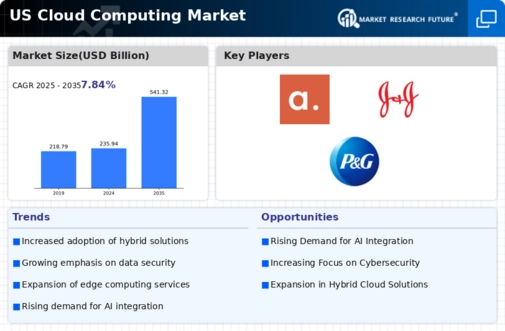Rising Demand for Scalability
The cloud computing market is experiencing a notable surge in demand for scalable solutions. Businesses are increasingly seeking flexible cloud services that can adapt to their fluctuating needs. This trend is particularly evident in sectors such as e-commerce and technology, where rapid growth necessitates scalable infrastructure. According to recent data, the cloud computing market is projected to reach approximately $500 billion by 2025, driven by the need for businesses to scale operations efficiently. Companies are leveraging cloud solutions to enhance their operational agility, allowing them to respond swiftly to market changes. This rising demand for scalability is a key driver in the cloud computing market, as organizations prioritize solutions that can grow alongside their business objectives.
Emergence of Remote Work Culture
The shift to remote work is a significant driver in the cloud computing market. As organizations adapt to flexible work arrangements, the demand for cloud-based collaboration tools and services has surged. This trend is reshaping how businesses operate, with cloud solutions enabling seamless communication and collaboration among remote teams. Data suggests that the market for cloud collaboration tools is expected to grow by over 20% annually, reflecting the increasing reliance on cloud technologies for remote work. Companies are investing in cloud infrastructure to support their distributed workforce, ensuring that employees have access to necessary resources from anywhere. This emergence of remote work culture is a key factor propelling the growth of the cloud computing market.
Cost Efficiency and Resource Optimization
Cost efficiency remains a pivotal driver in the cloud computing market. Organizations are increasingly recognizing the financial benefits of migrating to cloud-based solutions. By utilizing cloud services, businesses can significantly reduce their IT expenditures, as they no longer need to invest heavily in on-premises infrastructure. A recent analysis indicates that companies can save up to 30% on IT costs by adopting cloud solutions. This financial incentive is compelling, particularly for small and medium-sized enterprises (SMEs) that may have limited budgets. The ability to optimize resources and pay only for what is used further enhances the appeal of cloud computing. As a result, the drive for cost efficiency is reshaping the landscape of the cloud computing market, encouraging widespread adoption across various industries.
Advancements in Cloud Security Technologies
Advancements in cloud security technologies are playing a crucial role in the cloud computing market. As cyber threats become more sophisticated, cloud service providers are continuously innovating to enhance security measures. The introduction of advanced encryption techniques, multi-factor authentication, and AI-driven security analytics is helping organizations safeguard their data in the cloud. Recent statistics indicate that the cloud security market is projected to grow by 25% annually, reflecting the increasing importance of security in cloud adoption. Businesses are prioritizing security when selecting cloud solutions, as they seek to protect sensitive information and maintain customer trust. This focus on security advancements is a significant driver in the cloud computing market, influencing purchasing decisions and shaping service offerings.
Increased Regulatory Compliance Requirements
The cloud computing market is increasingly influenced by the need for regulatory compliance. As data privacy laws and industry regulations become more stringent, organizations are compelled to adopt cloud solutions that ensure compliance with these requirements. For instance, regulations such as the Health Insurance Portability and Accountability Act (HIPAA) and the General Data Protection Regulation (GDPR) necessitate robust data protection measures. Cloud service providers are responding by enhancing their security protocols and compliance certifications, making their offerings more attractive to businesses concerned about legal liabilities. This heightened focus on compliance is driving growth in the cloud computing market, as organizations seek solutions that not only meet operational needs but also adhere to regulatory standards.














Leave a Comment